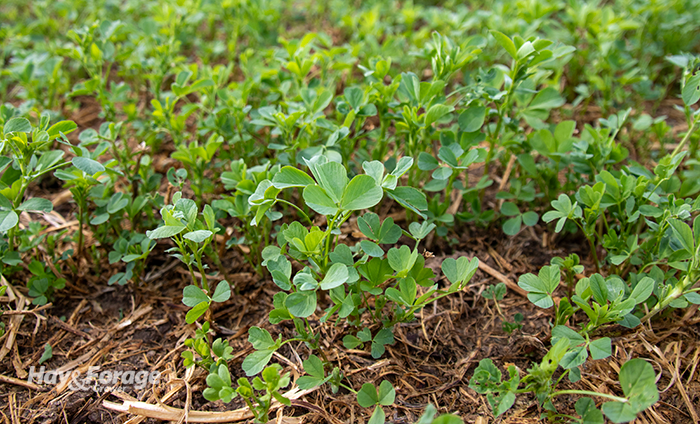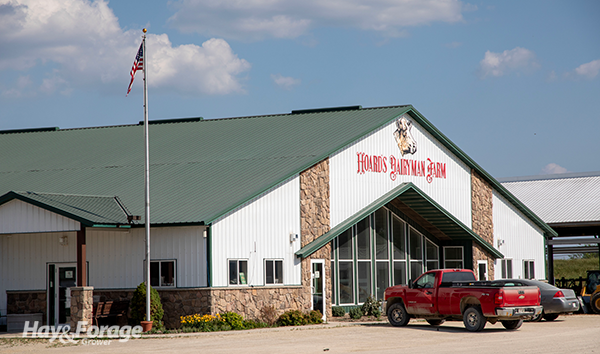
When I started working at Hay & Forage Grower, I got a front-row seat to all things alfalfa, from baling hay and chopping haylage to plant genetics and seed marketing. Little did I know I that along with all of this new information I was also signing up for a crash course in ruminant nutrition, especially considering our publishing company, W.D. Hoard & Sons, encompasses Hoard’s Dairyman magazine.
One unique aspect of our publishing company is that it owns and operates a commercial dairy farm near our office in Fort Atkinson, Wis. My first day on the job as an editorial intern included a tour of the farm, which is something we also offer to the public by appointment, attracting guests from across the country and around the world throughout the year. As I made a few more visits and became more familiar with the farm, I shadowed some other guides and started giving tours as well.
I’m not the most animated tour guide; I don’t engage in theatrics or have any puns up my sleeve. And I’m willing to bet that I learn more from each guest — whether farmer or nonfarmer — than they end up learning from me. But for the handful of tours I have given in the past, I’ve started out by warming visitors up with a brief history of the Hoard’s Dairyman Farm, emphasizing that it wouldn’t be here today if it wasn’t for alfalfa.
That punchline doesn’t always elicit the level of intrigue and enthusiasm that I’m after, but it doesn’t stop me from continuing to explain how the dairy, which can be found on the National Register of Historic Places, got its roots.

An alfalfa advocate
It was the late 1800s when W.D. Hoard, a newspaper publisher and former Wisconsin governor, launched Hoard’s Dairyman magazine. Promoting alfalfa as a viable feedstuff in Wisconsin was a prominent topic in the early issues, but without much evidence of available varieties being able to outlast harsh winters or survive humid summers, readers were not convinced. At the time, university agricultural specialists weren’t interested in growing or promoting alfalfa, either.
This prompted Hoard to take matters into his own hands — literally. Driving down a gravel road one day, he noticed a patch of healthy alfalfa growing along a fence line surrounded by the remnants of a failed seeding in an adjacent field. Assuming the enduring alfalfa had superior genetics, or that the lime dust kicked up by passing cars had supported its survival, he dug up about 100 plants and replanted them in an empty lot near his house in town to investigate.
Hoard continued to select for and experiment with persistent plants on a small scale until his alfalfa had proven itself worthy of being a permanent Wisconsinite — at least more permanent than the timothy and red clover that were common feed crops at the time despite losing productivity during the heat of the summer. When his makeshift forage plots outgrew the confines of the city lot, Hoard decided to expand his personal research and purchased farmland and a few cows just north of Fort Atkinson in 1899, establishing 8 acres of alfalfa there.
That 8-acre hayfield was essentially the start of the widespread adoption of alfalfa in the Badger State. It also opened the door to greater dairy production on the farm, starting with a small herd of Guernseys — Hoard’s breed of choice. Today, the Hoard’s Dairyman herd is the longest continuously registered Guernsey herd in North America, comprising about 300 milking cows.

Forage full circle
Those facts and figures find their way into most of my farm tours. Other tidbits I like to throw out there include the herd’s lactation average of 19,792 pounds of milk with 4.76% fat and 3.52% protein. I also add that mastitis is such a rare occurrence that not one cow in the robot barn has been treated for it in the past two years. The mention of the robot barn usually leads us to said barn, which is a popular stop for guests to see the four voluntary milking systems in action.
I try to enlighten tour-goers with other nuggets of forage knowledge when I can. For example, I’ll point out the difference in composition and particle size between the total mixed rations (TMRs) for heifers versus lactating cows as we walk through the freestall barn. I’ll also add that we hire a custom forage harvesting crew to plant and chop all of our alfalfa and corn silage when we approach the hayfield at the northwest corner of the property.

From there, I typically take visitors to see the calf hutches — another fan favorite — and usher them past the extensive lineup of silage bags where all of our fermented feed is stored to conclude the tour. I may be biased, but starting and ending on an alfalfa-related note seems only fitting considering its role in the farm’s history, as well as the history of America’s Dairyland.

